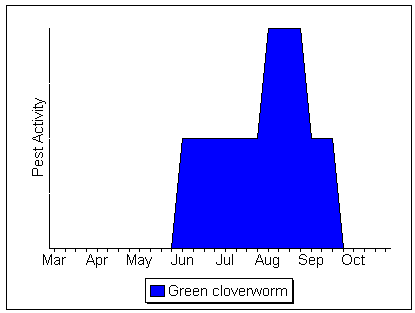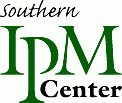Green Cloverworm in Soybeans
Green Cloverworm
Description
The larva stage of the green cloverworm is slender and grows to approximately one inch long. When disturbed they

Green Cloverworm
University of Kentucky Dept. Entomology
will wiggle violently. They are light green with two white stripes running the length of the body. The green cloverworm is often confused with the looper. Cloverworms can be easily distinguished by the number of abdominal prolegs near the center of the body. Cloverworms have three pairs. Loopers have one or two pairs of abdominal prolegs and most other soybean-infesting caterpillars have four pairs of abdominal prolegs. All three of these groups of caterpillars also have a pair of anal prolegs near the the tail end.
Damage
Green cloverworms feed extensively on soybean leaves. Young larvae skeletonize the underside of the leaf leaving the upper surface intact. Older larvae eat all of the leaf except for the largest veins. Normally they do not feed on pods.
IPM Techniques and Scouting
Larval populations of green cloverworm may not reach damaging levels because they are very susceptible to attack by parasites and diseases. Larvae that have been parasitized will be mottled brown in color and shrunken. Their bodies may be tapered at one or both ends. Diseased larvae are often found hanging from leaves and are powdery pink or white in color.
The green cloverworm occurs in Kentucky mid-June through August. A shake cloth should be used in sampling for green cloverworms. One four foot shake cloth sample should be taken at each scouting site. The number of sites you need to examine in a field is based on the size of the field.
Treatment decisions should consider several factors:
- number of cloverworm larvae per site ,
- number of parasitized or diseased larvae,
- growth stage of the soybean plant,
- percent defoliation,
- anticipated yield, and
- cost of the treatment.
Green Cloverworm Activity

Please note: These dates are approximations only. This calendar was constructed using data from Kentucky, USA. These dates may not apply in your area. You may wish to contact your county extension agent or agricultural consultant for information tailored to your locality.
References and Additional Information
- IPM-3 Kentucky IPM Manual for Soybeans
- ENT-13 Insecticide Recommendations for Soybeans 1998, University of Kentucky Entomology Extension Publication ENT-13, Lexington, KY, 1998
- Illinois Field Crop Scouting Manual
- Purdue University - Field Crops Pest Management Manual
- Handbook of Soybean Insect Pests by Leon G. Higley and David J. Boethel, Entomological Society of America


